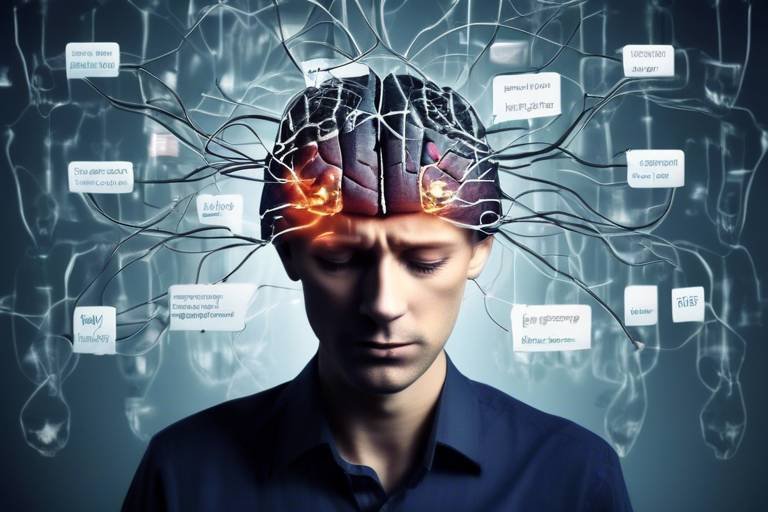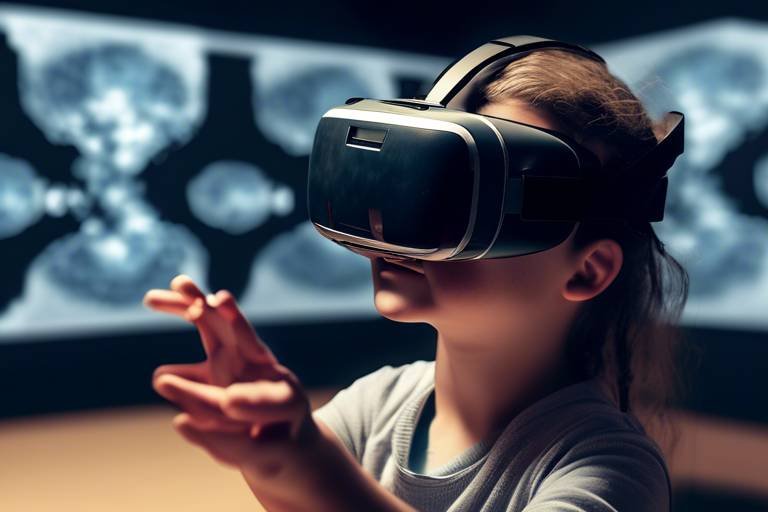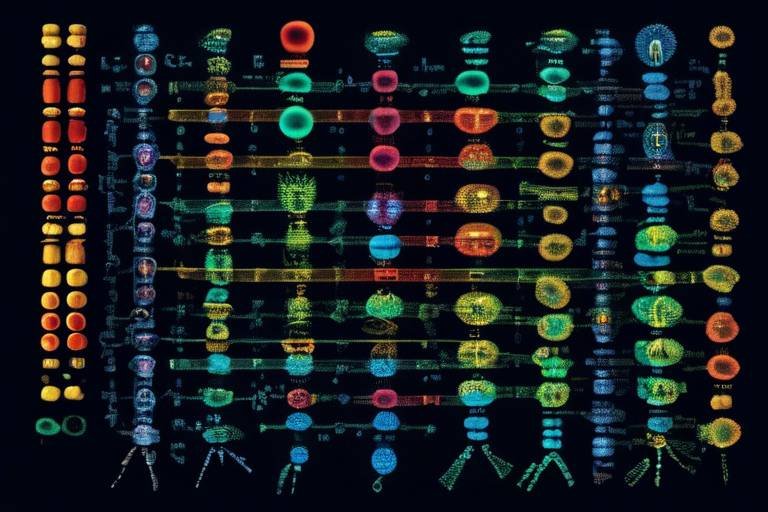How Technology is Impacting Cognitive Neuroscience
The intersection of technology and cognitive neuroscience is nothing short of revolutionary. As we dive into the intricacies of how technology is reshaping our understanding of the brain, it’s essential to recognize that these advancements are not merely tools; they are gateways to unlocking the mysteries of human cognition. Imagine being able to observe the brain in action, to see how thoughts are formed, and to understand the underlying mechanisms of disorders. This is the promise that technology holds for cognitive neuroscience, and it’s changing the way researchers approach the study of the mind.
One of the most significant ways technology is impacting cognitive neuroscience is through the development of advanced neuroimaging techniques. Technologies like functional Magnetic Resonance Imaging (fMRI) and Positron Emission Tomography (PET) scans have transformed our ability to visualize brain activity in real-time. These tools allow researchers to peer into the brain's inner workings, providing insights that were previously unimaginable. For instance, researchers can now observe how different areas of the brain light up during various cognitive tasks, enhancing our understanding of everything from memory formation to decision-making processes.
Moreover, the advent of artificial intelligence (AI) in research has taken cognitive neuroscience to new heights. AI’s ability to analyze vast amounts of data quickly and accurately has proven invaluable. It’s like having a supercharged assistant that can sift through mountains of information, identifying patterns and correlations that might elude even the most skilled human researchers. This capability not only streamlines the research process but also leads to more precise findings and robust theories about cognitive functions.
Within the realm of AI, machine learning techniques are particularly noteworthy. These methods can be applied to large datasets, allowing scientists to uncover complex relationships between brain activity and cognitive functions. For example, researchers can use machine learning to predict how individuals might respond to certain stimuli based on their unique brain activity patterns. This level of insight is akin to having a crystal ball that reveals the intricate dance of neurons and their connection to our thoughts and behaviors.
Another exciting development is the field of neuroinformatics, which merges neuroscience data with computational tools. This combination facilitates data sharing and analysis, accelerating research and fostering collaboration among scientists. Think of neuroinformatics as a bustling marketplace where ideas and data flow freely, leading to innovative breakthroughs that push the boundaries of what we know about the brain.
Data visualization tools also play a crucial role in this technological evolution. They help researchers interpret complex neuroimaging data, making it easier to present findings and communicate insights about brain function to broader audiences. Imagine trying to explain a complicated concept using only numbers and jargon; it would be a daunting task. However, with effective visualization, researchers can transform dense data into compelling stories that resonate with both the scientific community and the general public.
While the benefits of integrating technology into cognitive neuroscience are clear, ethical considerations must also be addressed. The use of AI raises important questions about data privacy, consent, and the implications of AI-driven findings on human cognition and behavior. As we navigate this brave new world, it’s vital to ensure that ethical standards keep pace with technological advancements, safeguarding the rights and well-being of individuals involved in research.
In addition to neuroimaging and AI, wearable technology is making waves in cognitive neuroscience. Devices like EEG headsets are providing new avenues for studying cognitive processes in real-world settings. Imagine being able to gather data on brain activity while someone goes about their daily life—this is now a reality thanks to wearables. These devices allow researchers to monitor cognitive performance dynamically, leading to a better understanding of how environmental factors influence brain function and cognitive behavior.
Furthermore, wearable technology is not just about observation; it also has therapeutic applications. Real-time feedback from these devices can help individuals manage conditions such as anxiety and attention disorders, enhancing their cognitive health. It’s like having a personal trainer for your brain, guiding you to optimize your mental well-being.
Finally, virtual reality (VR) is emerging as a powerful tool in cognitive neuroscience. By providing immersive environments for studying perception, memory, and learning, VR offers researchers a unique platform to explore cognitive processes. Additionally, VR is being utilized for therapeutic interventions, creating engaging experiences that can aid in the treatment of various psychological conditions.
- What is cognitive neuroscience? Cognitive neuroscience is the study of how brain function relates to cognitive processes such as perception, memory, and decision-making.
- How has technology improved research in cognitive neuroscience? Technology has introduced advanced neuroimaging techniques, AI-driven data analysis, and wearable devices that enhance our understanding of brain activity and cognitive functions.
- What ethical concerns arise from the use of AI in cognitive neuroscience? Ethical concerns include data privacy, consent, and the potential implications of AI findings on human cognition and behavior.
- Can wearable technology help with mental health issues? Yes, wearable devices can provide real-time feedback to help users manage conditions like anxiety and attention disorders.

Advancements in Neuroimaging
Neuroimaging technologies have truly transformed the landscape of cognitive neuroscience, acting as a window into the intricate workings of the human brain. Imagine being able to watch the brain light up in real-time as someone solves a puzzle or recalls a cherished memory. This is not science fiction; it’s the reality brought about by advancements in neuroimaging techniques like functional Magnetic Resonance Imaging (fMRI) and Positron Emission Tomography (PET). These tools have allowed researchers to visualize brain activity with unprecedented clarity, providing insights that were once thought impossible.
With fMRI, for example, scientists can measure brain activity by detecting changes associated with blood flow. When a specific brain region is more active, it consumes more oxygen, leading to increased blood flow in that area. This remarkable ability to map brain activity has led to significant breakthroughs in understanding cognitive processes such as memory, attention, and decision-making. Researchers can now observe how different brain regions communicate and cooperate during various tasks, revealing the brain's complex network of interactions.
Moreover, PET scans offer a different but equally valuable perspective by providing information about the brain's metabolic processes. This technique involves injecting a small amount of radioactive material into the bloodstream, which allows scientists to visualize areas of high metabolic activity. By analyzing these patterns, researchers can pinpoint regions that may be functioning abnormally, which is particularly useful in studying conditions like Alzheimer's disease or schizophrenia.
The evolution of neuroimaging techniques has not only enhanced our understanding of normal cognitive function but has also paved the way for identifying and diagnosing various neurological disorders. For instance, neuroimaging can help detect early signs of cognitive decline, enabling timely interventions that can significantly improve patient outcomes.
As we look to the future, the integration of advanced neuroimaging technologies with artificial intelligence is set to revolutionize the field even further. AI algorithms can analyze vast amounts of neuroimaging data, identifying patterns and correlations that human researchers might overlook. This synergy between technology and neuroscience is not just exciting; it’s a game-changer that promises to deepen our understanding of the brain and its functions.
In conclusion, the advancements in neuroimaging have opened up a world of possibilities in cognitive neuroscience. By enabling researchers to visualize brain activity and explore the underlying mechanisms of cognition, these technologies are not only enhancing our scientific knowledge but are also improving clinical practices. As we continue to innovate and refine these methods, the potential for new discoveries in understanding the human brain is limitless.
- What are the main types of neuroimaging techniques? The most common neuroimaging techniques include fMRI, PET scans, and EEG (electroencephalography).
- How does fMRI work? fMRI measures brain activity by detecting changes in blood flow, which is linked to neuronal activity.
- What are the applications of neuroimaging? Neuroimaging is used for both research and clinical purposes, including diagnosing neurological disorders and studying cognitive processes.
- Can neuroimaging predict cognitive decline? Yes, neuroimaging can help identify early signs of cognitive decline, potentially leading to earlier interventions.

Artificial Intelligence in Research
Artificial intelligence (AI) is rapidly transforming the landscape of cognitive neuroscience research. Imagine having a super-smart assistant that can sift through mountains of data in seconds, uncovering patterns and insights that human researchers might overlook. That's exactly what AI is doing in the field! By leveraging advanced algorithms and machine learning techniques, researchers are now able to analyze complex datasets more efficiently than ever before. This not only accelerates the research process but also enhances the accuracy of findings and theories.
One of the most exciting aspects of AI in cognitive neuroscience is its ability to identify subtle patterns in brain activity. For instance, AI can help researchers analyze data from neuroimaging studies, such as fMRI scans, to detect changes in brain function associated with different cognitive tasks. This capability allows scientists to develop more nuanced theories about how various cognitive processes, like memory and attention, are represented in the brain. The implications are profound, as these insights can lead to better diagnostic tools and treatment options for cognitive disorders.
Machine learning, a subset of AI, is particularly impactful in cognitive neuroscience. By applying machine learning techniques to large datasets, researchers can uncover intricate relationships between brain activity and cognitive functions. For example, a study might involve analyzing thousands of fMRI scans from participants performing a memory task. With machine learning algorithms, researchers can identify which brain regions are most active during specific cognitive processes, leading to a deeper understanding of how our minds work.
This approach not only enhances our knowledge of cognitive functions but also opens up new avenues for personalized medicine. Imagine a future where treatments for conditions like ADHD or depression are tailored to an individual's unique brain activity patterns, thanks to insights gained from AI-driven research. The potential for improving mental health outcomes is staggering!
Neuroinformatics is an emerging field that combines neuroscience data with computational tools, facilitating data sharing and analysis among researchers. This interdisciplinary approach is essential for advancing our understanding of the brain. By creating databases that house neuroimaging data, cognitive assessments, and genetic information, researchers can collaborate more effectively and build on each other's work. AI plays a crucial role here, as it can help manage and analyze these vast datasets, making it easier to draw meaningful conclusions.
Another area where AI shines is in data visualization. Cognitive neuroscience generates complex data that can be challenging to interpret. However, with the help of AI-driven data visualization tools, researchers can create clear and engaging representations of their findings. These tools allow scientists to present their research in a way that is accessible to a broader audience, including educators, policymakers, and the general public. By making complex data understandable, researchers can foster greater awareness and appreciation for the intricacies of brain function.
While the integration of AI in cognitive neuroscience offers exciting possibilities, it also raises important ethical considerations. Issues such as data privacy, informed consent, and the potential implications of AI-driven findings on human cognition and behavior must be carefully addressed. As researchers harness the power of AI, they must also prioritize ethical guidelines to ensure that their work respects the rights and dignity of individuals.
In conclusion, the infusion of artificial intelligence into cognitive neuroscience is revolutionizing our understanding of the brain. From enhancing data analysis to uncovering complex relationships between brain activity and cognition, AI is paving the way for groundbreaking discoveries that could reshape the future of mental health treatment. As we continue to explore these advancements, it's crucial to remain vigilant about the ethical implications of our work, ensuring that we use technology responsibly in the pursuit of knowledge.
- What is the role of AI in cognitive neuroscience? AI helps researchers analyze large datasets, identify patterns, and enhance predictive modeling, leading to more accurate findings.
- How does machine learning contribute to cognitive neuroscience? Machine learning techniques allow researchers to uncover complex relationships between brain activity and cognitive functions, improving our understanding of mental processes.
- What are the ethical concerns surrounding AI in research? Ethical concerns include data privacy, informed consent, and the implications of AI findings on human cognition and behavior.
- How can neuroinformatics aid in cognitive neuroscience research? Neuroinformatics combines neuroscience data with computational tools, facilitating data sharing and analysis, which accelerates research and fosters collaboration.

Machine Learning Techniques
Machine learning techniques are revolutionizing the field of cognitive neuroscience by enabling researchers to analyze vast amounts of data like never before. Imagine having a tool that can sift through terabytes of information, identify patterns, and even predict outcomes based on previous data. This is precisely what machine learning brings to the table. By applying algorithms to large datasets, scientists can uncover intricate relationships between brain activity and cognitive functions, enhancing our understanding of how our minds work.
One of the most exciting aspects of machine learning in cognitive neuroscience is its ability to process neuroimaging data. Traditional methods of analysis can be time-consuming and often miss subtle patterns that might be crucial for understanding complex cognitive processes. However, with machine learning, researchers can leverage techniques such as supervised learning, unsupervised learning, and reinforcement learning to extract meaningful insights from data. For example:
- Supervised Learning: This involves training algorithms on labeled data, allowing them to make predictions or classifications based on new, unseen data. In cognitive neuroscience, this could mean predicting a patient's cognitive decline based on their brain scans.
- Unsupervised Learning: Here, algorithms identify patterns in data without prior labels. This technique can reveal hidden structures in brain activity that researchers were previously unaware of.
- Reinforcement Learning: This method teaches algorithms to make decisions by rewarding them for correct actions. In cognitive neuroscience, this could be applied to study how learning occurs in the brain during various tasks.
Moreover, machine learning techniques are not just limited to data analysis; they also enhance predictive modeling in cognitive neuroscience. By creating models that can simulate brain function, researchers can test hypotheses and explore the potential impacts of different variables on cognitive processes. This predictive power is invaluable, as it allows scientists to explore “what-if” scenarios and understand the potential consequences of various cognitive interventions.
As we delve deeper into the realm of machine learning, it becomes evident that neuroinformatics plays a vital role in this integration. Neuroinformatics combines neuroscience data with computational tools, facilitating data sharing and analysis. This collaboration accelerates research and fosters a community of scientists who can build off each other's findings. Together, these advancements are propelling cognitive neuroscience into a new era of discovery.
However, with great power comes great responsibility. As researchers embrace machine learning techniques, they must also navigate the ethical implications of their work. Questions surrounding data privacy, consent, and the effects of AI-driven findings on human cognition and behavior must be addressed to ensure that the advancements in cognitive neuroscience are both beneficial and ethical.
Q: How does machine learning improve cognitive neuroscience research?
A: Machine learning enhances cognitive neuroscience research by analyzing large datasets to uncover patterns and relationships that traditional methods might miss. This leads to more accurate findings and a deeper understanding of cognitive functions.
Q: What are the different types of machine learning techniques used in cognitive neuroscience?
A: The main types of machine learning techniques used in cognitive neuroscience include supervised learning, unsupervised learning, and reinforcement learning, each serving different purposes in data analysis and predictive modeling.
Q: What ethical considerations arise from using machine learning in cognitive neuroscience?
A: Ethical considerations include data privacy, informed consent, and the implications of AI findings on human cognition and behavior, which researchers must carefully navigate to ensure responsible use of technology.

Neuroinformatics
Neuroinformatics is an exciting interdisciplinary field that merges neuroscience with computational tools, creating a robust framework for understanding the brain's complexities. Imagine having a treasure chest filled with invaluable data from various studies, but without the right tools to unlock it. That's where neuroinformatics comes into play, providing the keys to access and interpret this vast wealth of information. By integrating data from neuroimaging, electrophysiological recordings, and behavioral studies, neuroinformatics enables researchers to develop comprehensive models of brain function and cognition.
One of the most remarkable aspects of neuroinformatics is its emphasis on data sharing and collaboration. In the past, researchers often worked in silos, leading to duplicated efforts and fragmented knowledge. However, with neuroinformatics, scientists can share their datasets, methodologies, and findings with peers across the globe. This collaborative spirit accelerates the pace of discovery, allowing for a more holistic understanding of cognitive processes and brain disorders. For instance, large-scale databases like the Human Connectome Project provide a platform for researchers to access and contribute to a growing repository of neuroimaging and behavioral data.
Furthermore, neuroinformatics facilitates the development of sophisticated analytical tools. These tools can process massive amounts of data, extracting meaningful patterns and insights that would be nearly impossible to discern manually. Consider it akin to having a super-sleuth on your team, one that can sift through mountains of information and highlight the most critical findings. By utilizing machine learning algorithms and advanced statistical techniques, researchers can identify correlations between brain activity and cognitive functions, leading to breakthroughs in our understanding of mental processes.
Here’s a brief overview of the key components of neuroinformatics:
- Data Integration: Combining various types of data (e.g., genetic, imaging, behavioral) to provide a comprehensive view of brain function.
- Data Sharing: Creating platforms for researchers to share datasets and findings, fostering collaboration and accelerating research.
- Analytical Tools: Developing software and algorithms that can analyze large datasets, uncovering hidden patterns and relationships.
- Modeling and Simulation: Building computational models that simulate brain processes, helping to predict outcomes and understand complex interactions.
As we venture deeper into the realm of neuroinformatics, the potential for transformative discoveries grows exponentially. By harnessing the power of technology and collaboration, researchers can tackle some of the most pressing questions in cognitive neuroscience. What happens in the brain during complex decision-making? How do different brain regions communicate during memory retrieval? With neuroinformatics, the answers to these questions are becoming increasingly attainable, paving the way for advancements that could revolutionize our understanding of the human mind.

Data Visualization Tools
In the realm of cognitive neuroscience, the complexities of brain function and cognitive processes can often resemble a labyrinth. This is where come into play, acting as a guiding light that helps researchers navigate through intricate datasets. These tools transform raw data into visual formats, such as graphs, heat maps, and 3D models, making it easier for scientists to interpret and communicate their findings. Imagine trying to decipher a complicated puzzle; without a clear picture, it’s nearly impossible. Similarly, data visualization provides that clarity, enabling researchers to see patterns and trends that might otherwise remain hidden.
One of the most significant advantages of using data visualization tools is their ability to convey complex information quickly and effectively. For instance, a well-designed graph can summarize extensive neuroimaging data in a way that is digestible for both scientific and non-scientific audiences. This is crucial, especially when presenting findings to stakeholders, funding bodies, or the general public. The visual representation of data not only enhances understanding but also fosters engagement and encourages collaboration among researchers from different fields.
Moreover, many of these tools come equipped with interactive features that allow users to manipulate the data in real time. This interactivity can lead to new insights and hypotheses, as researchers can explore different scenarios and visualize outcomes instantly. For example, a cognitive neuroscientist might use a tool that allows them to adjust variables related to brain activity and immediately see how those changes affect cognitive performance. This capability transforms the research process from a static experience to a dynamic exploration, much like a video game where each decision leads to different outcomes.
To illustrate the impact of data visualization tools in cognitive neuroscience, consider the following table that highlights some popular tools and their applications:
| Tool Name | Application | Key Features |
|---|---|---|
| Tableau | Data analysis and visualization | Interactive dashboards, real-time data updates |
| BrainVoyager | Neuroimaging data visualization | 3D visualization, statistical analysis tools |
| MATLAB | Mathematical modeling and data visualization | Extensive libraries, customizable graphics |
| R (ggplot2) | Statistical data visualization | Flexible plotting system, easy integration with statistical analysis |
As the field of cognitive neuroscience continues to evolve, the importance of data visualization tools cannot be overstated. They not only enhance the research process but also bridge the gap between complex scientific data and public understanding. In a world where information overload is the norm, these tools empower researchers to present their findings in a way that is both accessible and impactful. By harnessing the power of visualization, cognitive neuroscientists can illuminate the mysteries of the brain, paving the way for advancements in our understanding of cognition and behavior.
- What are data visualization tools? Data visualization tools are software applications that allow researchers to create visual representations of data, making it easier to interpret and communicate findings.
- How do these tools benefit cognitive neuroscience research? They help simplify complex data, reveal patterns, and facilitate better communication of findings to various audiences.
- Can anyone use data visualization tools? Yes, many tools are designed to be user-friendly, allowing researchers from various backgrounds to utilize them effectively.
- What are some popular data visualization tools? Some popular tools include Tableau, BrainVoyager, MATLAB, and R (ggplot2).

Ethical Considerations in AI
The integration of artificial intelligence (AI) into cognitive neuroscience is not just a technical leap; it also brings forth a myriad of ethical considerations that researchers and practitioners must navigate. As we harness the power of AI to analyze vast datasets and uncover intricate patterns in brain activity, we must also ask ourselves: what are the implications of these advancements on individual privacy, consent, and the broader societal context?
One of the foremost concerns is data privacy. With AI systems requiring access to extensive datasets, including sensitive personal information, the risk of breaches or misuse is heightened. Imagine a scenario where your brain activity data, collected through neuroimaging or wearable devices, is accessed by unauthorized entities. This raises alarming questions about who controls this data and how it is used. Ensuring robust data protection measures is essential to safeguard individuals' rights.
Another critical aspect is the issue of informed consent. Participants in cognitive neuroscience studies often provide data for research purposes, but do they fully understand how their information will be utilized? As AI algorithms become more complex, the transparency of these processes becomes obscured. Researchers must ensure that participants are not only informed but also truly comprehend the implications of their contributions. This involves clear communication about how their data will be analyzed and shared.
Moreover, the implications of AI-driven findings on human cognition and behavior cannot be overlooked. As we develop AI systems that can predict or even influence cognitive outcomes, we must grapple with the ethical ramifications. For instance, if an AI model suggests interventions for mental health based on brain activity patterns, how do we ensure that these recommendations are ethical and do not inadvertently harm individuals? The potential for misuse of AI in manipulating cognitive processes is a serious concern that warrants careful consideration.
In summary, while AI holds immense potential for advancing cognitive neuroscience, it is imperative that we approach its integration with caution. Addressing these ethical considerations requires a collaborative effort among researchers, ethicists, and policymakers to establish guidelines that prioritize human dignity and social responsibility. Only then can we harness the full potential of AI in a manner that benefits society as a whole.
- What are the main ethical concerns regarding AI in cognitive neuroscience?
The main ethical concerns include data privacy, informed consent, and the implications of AI-driven findings on human cognition and behavior. - How can researchers ensure data privacy?
Researchers can implement robust data protection measures, anonymize data, and limit access to sensitive information to safeguard participants' privacy. - What is informed consent in the context of AI?
Informed consent involves ensuring that participants fully understand how their data will be used and the potential implications of their participation in research. - Can AI influence cognitive outcomes?
Yes, AI can suggest interventions based on brain activity patterns, but this raises ethical concerns about the potential for misuse or harm.

Wearable Technology
In today's fast-paced world, is not just a trend; it’s a revolution that’s reshaping the landscape of cognitive neuroscience. Imagine having a device that not only tracks your steps but also monitors your brain activity in real time! This is the power of wearable tech, such as EEG headsets and smart glasses, which are paving the way for groundbreaking research into cognitive processes in everyday settings. By harnessing these devices, researchers can gather invaluable data on how our brains function during daily activities, providing insights that traditional lab settings simply can't offer.
What’s truly fascinating about wearable technology is its ability to collect data continuously and in real-time. This means that researchers can observe how various factors—like stress, sleep, or even social interactions—affect cognitive performance as they happen. For example, if someone is wearing an EEG headset while going through their daily routine, researchers can analyze how their brain responds to different stimuli throughout the day. This dynamic approach allows for a much richer understanding of cognitive behavior compared to static lab experiments.
Moreover, the implications of wearable technology extend beyond just research. These devices are being developed for therapeutic applications as well. Imagine a world where a wearable device can provide real-time feedback to manage anxiety or attention disorders. Users can receive alerts when their cognitive load is too high or when they need to take a break, making it easier to manage their mental health proactively. This kind of technology could empower individuals to take charge of their cognitive well-being, which is a significant step forward in the field of neuroscience.
To illustrate the impact of wearable technology in cognitive neuroscience, consider the following table that highlights some of the key features and applications of these devices:
| Device Type | Key Features | Applications |
|---|---|---|
| EEG Headsets | Real-time brain activity monitoring, portable | Cognitive performance assessment, therapeutic feedback |
| Smart Glasses | Augmented reality integration, visual data display | Memory and perception studies, interactive learning |
| Fitness Trackers | Heart rate monitoring, sleep tracking | Stress management, cognitive load assessment |
As we continue to explore the capabilities of wearable technology, it’s essential to keep in mind the ethical considerations that accompany this innovation. With the ability to collect sensitive data about an individual’s brain activity, issues of privacy and consent become paramount. Researchers must navigate these challenges carefully to ensure that the benefits of wearable technology do not come at the cost of personal privacy.
In conclusion, wearable technology is not just enhancing our understanding of cognitive processes; it is also transforming how we approach mental health and cognitive performance. By allowing researchers to study the brain in real-world contexts and providing users with tools for managing their cognitive health, wearables are truly at the forefront of the cognitive neuroscience revolution.
- What types of wearable technology are used in cognitive neuroscience?
Wearable technology includes EEG headsets, smart glasses, and fitness trackers, each serving unique functions in cognitive research. - How does wearable technology improve cognitive health?
These devices provide real-time feedback and data that can help users manage conditions like anxiety and attention disorders. - Are there ethical concerns with wearable technology?
Yes, issues related to data privacy and consent are critical considerations in the development and use of wearable devices.

Real-Time Cognitive Monitoring
Imagine being able to peek inside your brain while you go about your daily life—sounds like science fiction, right? Well, thanks to advancements in wearable technology, this is becoming a reality! Real-time cognitive monitoring allows researchers to track brain activity in real-world settings, providing invaluable insights into how we think, learn, and behave in our everyday environments.
Wearable devices, such as EEG headsets, have made it possible to capture brain wave patterns as they happen. This means that instead of relying solely on controlled lab settings, scientists can gather data during routine activities like walking, talking, or even while you're at work. This shift from traditional methods to real-time monitoring is akin to moving from static photographs to dynamic videos; it gives a much clearer picture of cognitive processes as they unfold.
One of the most exciting aspects of real-time cognitive monitoring is the potential to assess cognitive performance dynamically. For instance, researchers can analyze how different environmental factors—such as noise, lighting, or even stress—impact brain function and cognitive behavior. This real-time feedback loop not only enhances our understanding of cognitive processes but also allows for immediate adjustments to improve performance. Think of it as having a personal coach who provides instant feedback on your mental state, helping you navigate challenges more effectively.
Additionally, the data collected from these wearable devices can be incredibly rich. Researchers can track various metrics, including:
- Attention levels: Monitoring how focused an individual is during different tasks.
- Memory recall: Assessing how well information is retained and retrieved in real-time.
- Cognitive fatigue: Identifying when a person is becoming mentally exhausted.
This wealth of data opens up new avenues for research and application. For example, educators can use insights from cognitive monitoring to tailor their teaching strategies to better fit the needs of their students. Similarly, employers could leverage this technology to enhance workplace productivity by understanding when employees are most engaged or distracted.
However, with great power comes great responsibility. The ethical implications of real-time cognitive monitoring cannot be ignored. Issues surrounding privacy and consent must be addressed to ensure that individuals are fully aware of how their data is being used and that they have control over it. As we venture further into this exciting frontier, it’s crucial to strike a balance between innovation and ethical considerations.
In conclusion, real-time cognitive monitoring is not just a technological marvel; it's a game-changer for cognitive neuroscience. By providing insights into how our brains function in everyday situations, it enhances our understanding of cognitive processes and opens the door to practical applications that can improve our mental health and performance. The future looks bright, but we must tread carefully to ensure that we harness this potential responsibly.
- What is real-time cognitive monitoring?
Real-time cognitive monitoring involves using wearable devices to track brain activity as it occurs in everyday settings, providing insights into cognitive processes. - How does wearable technology work in cognitive neuroscience?
Wearable technology, such as EEG headsets, captures brain wave patterns and other metrics, allowing researchers to analyze cognitive performance dynamically. - What are the potential applications of real-time cognitive monitoring?
This technology can be used in education, workplace productivity, and mental health management, among other fields. - Are there ethical concerns with real-time cognitive monitoring?
Yes, issues surrounding privacy, consent, and data usage must be carefully considered to protect individuals' rights.

Therapeutic Applications
The advent of wearable technology has opened up a treasure trove of possibilities for therapeutic applications in cognitive neuroscience. Imagine a world where your brain's health is monitored in real-time, much like how fitness trackers keep tabs on your physical activity. These devices, such as EEG headsets, are not just gadgets; they are windows into our cognitive processes, enabling researchers and clinicians to gather invaluable data during everyday activities.
One of the most exciting aspects of these wearable devices is their ability to provide real-time feedback. For instance, individuals suffering from anxiety or attention disorders can benefit immensely from immediate insights into their cognitive states. When a user feels their anxiety levels rising, a wearable device can alert them, offering techniques to manage their stress effectively. This kind of immediate intervention can be a game-changer, transforming how we approach mental health.
Moreover, wearable technology can assist in personalized therapy. By collecting data on an individual's brain activity patterns over time, therapists can tailor interventions to fit the unique needs of each patient. For example, if a patient shows increased brain activity in response to specific triggers, therapists can develop customized coping strategies to help mitigate these reactions. This level of personalization not only enhances the effectiveness of treatments but also empowers patients by involving them in their own recovery journey.
To illustrate the impact of wearable technology on therapeutic applications, consider the following table:
| Condition | Wearable Device Application | Potential Benefits |
|---|---|---|
| Anxiety Disorders | Real-time monitoring and feedback | Immediate coping strategies and reduced anxiety levels |
| Attention Deficit Hyperactivity Disorder (ADHD) | Cognitive performance tracking | Personalized interventions to improve focus |
| Depression | Mood tracking and activity correlation | Better understanding of triggers and effective management strategies |
As we delve deeper into the therapeutic applications of these devices, it's essential to acknowledge the significant role they play in promoting self-awareness. Users can gain insights into their cognitive patterns, leading to a better understanding of how their thoughts and behaviors are interconnected. This self-awareness is a crucial step in the journey toward mental wellness, as it empowers individuals to take control of their cognitive health.
Furthermore, the integration of these technologies into therapy sessions can foster a collaborative environment between the therapist and the patient. By sharing real-time data, both parties can engage in meaningful discussions about progress and setbacks, leading to more effective treatment plans. This partnership not only enhances the therapeutic process but also builds trust and accountability.
In conclusion, the therapeutic applications of wearable technology in cognitive neuroscience are not merely futuristic concepts; they are actively reshaping how we understand and manage mental health. With the potential to provide real-time feedback, personalized interventions, and increased self-awareness, these devices are paving the way for a new era in mental health treatment. As technology continues to evolve, we can anticipate even more innovative solutions that will enhance our cognitive well-being.
- What types of wearable devices are used in cognitive neuroscience? Wearable devices like EEG headsets, smartwatches, and fitness trackers are commonly used to monitor brain activity and cognitive functions.
- How do wearable devices help with mental health? They provide real-time feedback, enabling users to manage their cognitive states and personalize therapeutic interventions.
- Are there any risks associated with using wearable technology for cognitive monitoring? While generally safe, concerns about data privacy and the accuracy of the devices should be considered.

Virtual Reality in Cognitive Research
Virtual reality (VR) is not just a playground for gamers; it has emerged as a transformative tool in the realm of cognitive neuroscience. Imagine stepping into a world where you can manipulate environments, interact with stimuli, and observe brain responses in real-time! This immersive technology offers researchers a unique platform to study complex cognitive functions such as perception, memory, and learning. By simulating real-world scenarios, VR allows scientists to create controlled experiments that were once difficult to achieve in traditional settings.
One of the most exciting aspects of VR in cognitive research is its ability to create immersive environments that can be tailored to specific research questions. For instance, researchers can design virtual spaces that mimic social interactions, test memory recall in a realistic setting, or even simulate stressful situations to study their effects on cognitive performance. This level of control and immersion helps in understanding how the brain processes information in different contexts, providing insights that are often unattainable through conventional methods.
Moreover, VR is proving to be an invaluable asset in therapeutic interventions. For example, individuals with anxiety disorders can be gradually exposed to their fears in a safe, controlled virtual environment. This method, known as exposure therapy, allows patients to confront their anxieties while being monitored for physiological changes, which can lead to more effective treatment outcomes. Additionally, VR applications are being developed for cognitive rehabilitation, helping stroke or brain injury patients regain lost skills through engaging and interactive experiences.
As we embrace this technology, it’s essential to consider its implications. Researchers must ensure that the data collected through VR experiments are ethically sourced and that participants are fully aware of their involvement. The immersive nature of VR can sometimes lead to heightened emotional responses, which raises questions about how these experiences might influence the data gathered. Therefore, maintaining ethical standards in VR research is paramount.
In summary, virtual reality is revolutionizing cognitive neuroscience by providing innovative ways to explore and understand the brain. Its ability to create immersive, controlled environments enables researchers to investigate cognitive processes that were previously challenging to study. As VR technology continues to evolve, it holds the potential not only to advance our understanding of cognitive functions but also to enhance therapeutic practices for various psychological conditions.
- What is the role of virtual reality in cognitive neuroscience?
Virtual reality allows researchers to create controlled and immersive environments to study cognitive processes like perception, memory, and learning in ways that traditional methods cannot. - How can VR be used for therapeutic purposes?
VR can be used in therapeutic settings, such as exposure therapy for anxiety disorders, allowing patients to confront their fears in a safe environment, which can lead to better treatment outcomes. - Are there ethical concerns associated with using VR in research?
Yes, ethical concerns include ensuring informed consent, data privacy, and understanding how immersive experiences may affect participants emotionally and cognitively.
Frequently Asked Questions
- What is cognitive neuroscience?
Cognitive neuroscience is a field that explores the relationship between brain function and cognitive processes. It aims to understand how our brain enables us to think, learn, and remember by examining the neural mechanisms underlying these activities.
- How has technology advanced neuroimaging?
Technology has significantly advanced neuroimaging through tools like fMRI and PET scans, allowing researchers to visualize brain activity in real-time. This has led to deeper insights into cognitive functions and disorders, making it easier to understand how different areas of the brain contribute to our thoughts and behaviors.
- What role does artificial intelligence play in cognitive neuroscience?
Artificial intelligence enhances cognitive neuroscience by improving data analysis and pattern recognition in research. It helps identify complex relationships within large datasets, leading to more accurate findings and predictive models that can explain cognitive processes better.
- Can you explain machine learning techniques in this context?
Machine learning techniques analyze vast amounts of neuroimaging data, allowing researchers to uncover intricate connections between brain activity and cognitive functions. This approach enhances our understanding of mental processes and can even predict cognitive behaviors based on neural patterns.
- What is neuroinformatics?
Neuroinformatics is the integration of neuroscience data with computational tools, facilitating data sharing and analysis. This collaboration accelerates research in cognitive neuroscience, enabling scientists to work together more effectively and share their findings.
- How do data visualization tools help researchers?
Data visualization tools help researchers interpret complex neuroimaging data, making it easier to present findings. By transforming intricate data into visual formats, these tools enable clearer communication of insights about brain function and cognitive processes to a broader audience.
- What ethical considerations arise with AI in cognitive neuroscience?
The integration of AI in cognitive neuroscience raises ethical concerns such as data privacy, informed consent, and the potential implications of AI-driven findings on human cognition and behavior. It’s crucial to address these issues to ensure responsible research practices.
- How is wearable technology changing cognitive research?
Wearable technology, like EEG headsets, allows researchers to study cognitive processes in real-world settings. This technology enables the collection of data on brain activity during daily activities, providing insights into how our environment affects cognitive behavior.
- What is real-time cognitive monitoring?
Real-time cognitive monitoring through wearables assesses cognitive performance dynamically. This approach helps researchers understand how various environmental factors influence brain function and cognitive behavior, leading to more tailored interventions.
- How are wearables used for therapeutic applications?
Wearable devices are being developed to provide real-time feedback for managing conditions like anxiety and attention disorders. By offering immediate insights, these devices enhance cognitive health and empower users to take charge of their mental well-being.
- What is the role of virtual reality in cognitive neuroscience?
Virtual reality (VR) serves as a powerful tool in cognitive neuroscience by creating immersive environments for studying perception, memory, and learning. Additionally, VR is being utilized for therapeutic interventions, providing new ways to treat cognitive and psychological conditions.



















